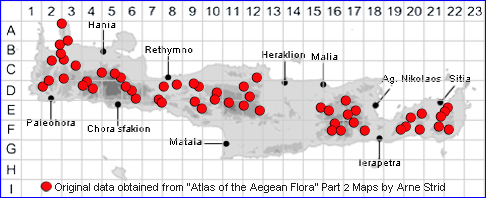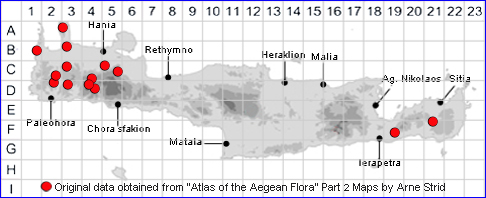

SPECIES DESCRIPTION
TRIFOLIUM PHYSODES
Including: Trifolium rechingeri
Family and Genus:- See- LEGUMINOSAE/Subgen. LOTOIDES/Sect.
Common Names:- None
Homotypic Synonyms:- Amoria physodes, Galearia physodes, Trifolium
fragiferum subsp. physodes, Xerosphaera physodes.
Meaning:- Trifolium (L) With three leaflets.
Physodes (Gr) Puffed out, inflated-looking.
General description:- Hairless, perennial.
Stems:-
1) 5-25 cm, procumbent or ascending, not rooting at the nodes.
Leaves:-
1) Leaflets, 10-20(-25) mm, ovate or elliptical to obovate-orbicular.
2) Stipules, lanceolate, aristate.
Flowers:-
1) Heads, 15-20 mm wide, globose or ovoid.
2) Peduncles, 10-80 mm.
3) Bracts, 0·5-1 mm, free, shorter than or equalling the pedicels.
4) Calyx, adaxial part of the calyx tube hairy, much inflated and reticulate-veined in
fruit.
a) teeth, lanceolate, porrect, lower, subulate, straight, somewhat longer than the
tube.
5) Corolla, 8-14 mm,white or pinkish.
Key features:-
1) Calyx-tube, in fruit pubescent and gibbous above, reticulate-veined in fruit.
2) Bracts, 0·5-1 mm, free.
Habitat:- Dry open shrubby vegetation, open woodland, gorges, rocky outcrops in
meadows. 0-1100(-1700) m.
Distribution:- Common in much of Greece, Rare on E. Aegean Islands.
Widespread in S Europe and SW. Asia. Fairly widespread on Crete.
Flowering time:- Late Mar to mid-June.
Photos by:- Dr. Armin Jage
TRIFOLIUM RECHINGERI
Meaning:- Rechingeri (L) Possibly for the Austrian botanist Karl Rechinger (1867-1952).
Resembling Trifolium physodes, but differing in the following characters:
1) Leaflets of the upper leaves broadly obovate, truncate.
2) Stems, petioles, stipules and bracts hairy.
3) Flowering heads, smaller.
4) Calyx tube, villous-lanate throughout.
5) Corolla, c. 7 mm.
Habitat:- Seasonally wet, often somewhat nitrified spots in dry open shrubby vegetation, fallow terraced fields and open woodland of Cupressus sempervirens & Pinus halepensis subsp. brutia, 0-1200 m.
Distribution:- Not recorded outside the Aegean area.
Flowering time:- April-May.
Photos, currently unavailabe
Meaning:- Rechingeri (L) Possibly for the Austrian botanist Karl Rechinger (1867-1952).
Resembling Trifolium physodes, but differing in the following characters:
1) Leaflets of the upper leaves broadly obovate, truncate.
2) Stems, petioles, stipules and bracts hairy.
3) Flowering heads, smaller.
4) Calyx tube, villous-lanate throughout.
5) Corolla, c. 7 mm.
Habitat:- Seasonally wet, often somewhat nitrified spots in dry open shrubby vegetation, fallow terraced fields and open woodland of Cupressus sempervirens & Pinus halepensis subsp. brutia, 0-1200 m.
Distribution:- Not recorded outside the Aegean area.
Flowering time:- April-May.
Photos, currently unavailabe
~~~~~~~~~~~~~~~~~~~~~~~~~~~~~~~~~~~~~~~~~~~~~~~~~~~~~~~~

